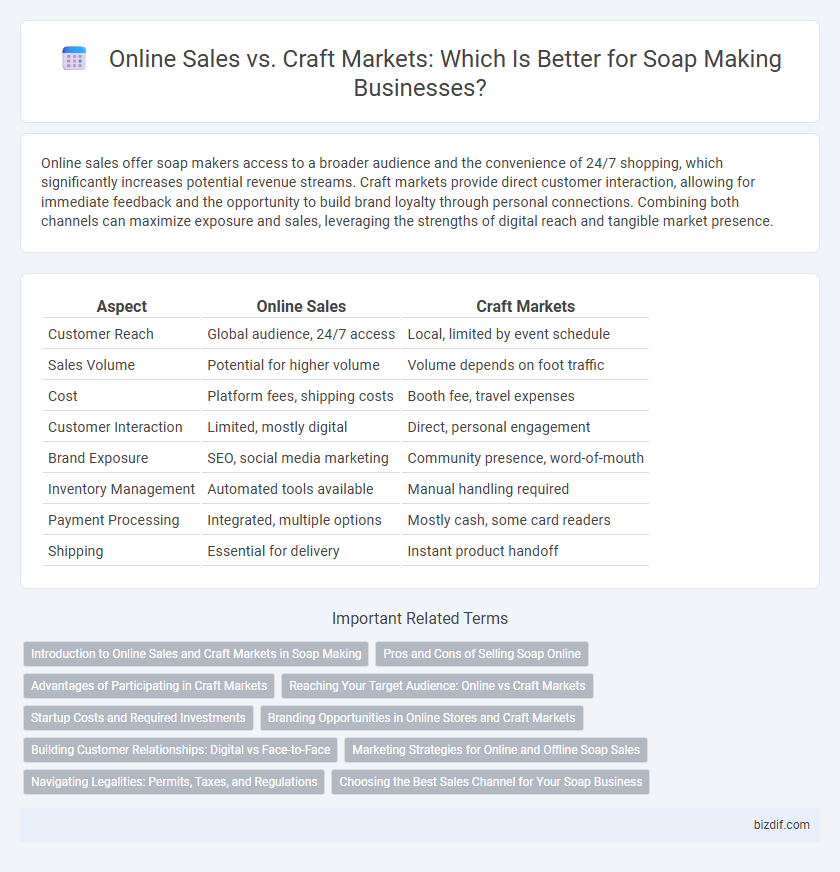Online sales offer soap makers access to a broader audience and the convenience of 24/7 shopping, which significantly increases potential revenue streams. Craft markets provide direct customer interaction, allowing for immediate feedback and the opportunity to build brand loyalty through personal connections. Combining both channels can maximize exposure and sales, leveraging the strengths of digital reach and tangible market presence.
Table of Comparison
| Aspect | Online Sales | Craft Markets |
|---|---|---|
| Customer Reach | Global audience, 24/7 access | Local, limited by event schedule |
| Sales Volume | Potential for higher volume | Volume depends on foot traffic |
| Cost | Platform fees, shipping costs | Booth fee, travel expenses |
| Customer Interaction | Limited, mostly digital | Direct, personal engagement |
| Brand Exposure | SEO, social media marketing | Community presence, word-of-mouth |
| Inventory Management | Automated tools available | Manual handling required |
| Payment Processing | Integrated, multiple options | Mostly cash, some card readers |
| Shipping | Essential for delivery | Instant product handoff |
Introduction to Online Sales and Craft Markets in Soap Making
Online sales in soap making provide a global platform for artisans to showcase diverse products, reaching a wider audience beyond local boundaries. Craft markets offer hands-on, direct interaction with customers, allowing soap makers to demonstrate product quality and build personal relationships. Both sales channels complement each other, enhancing brand visibility and boosting revenue streams for soap artisans.
Pros and Cons of Selling Soap Online
Selling soap online offers access to a global customer base and lower overhead costs compared to craft markets but faces challenges such as intense competition and the need for effective digital marketing strategies. Customers can conveniently browse detailed product descriptions and reviews, yet they miss the tactile experience of smelling and touching the soap before purchase. Shipping logistics and potential delays also impact customer satisfaction, while e-commerce platforms provide analytics and automation that are not available in face-to-face craft market sales.
Advantages of Participating in Craft Markets
Participating in craft markets offers soap makers direct customer interaction, enabling personalized feedback and building brand loyalty through face-to-face engagement. Craft markets provide immediate sales opportunities without the need for complex online logistics, reducing overhead costs and return rates. These venues also allow artisans to showcase the sensory qualities of their soaps, such as scent and texture, which online sales cannot fully convey.
Reaching Your Target Audience: Online vs Craft Markets
Online sales platforms enable soap makers to reach a global audience through targeted digital marketing, SEO optimization, and social media engagement, maximizing visibility to niche customer segments interested in handmade and natural products. Craft markets offer direct, face-to-face interactions that allow artisans to build personal connections, receive immediate feedback, and attract local customers who value tactile shopping experiences and artisan craftsmanship. Combining both channels optimizes market reach by leveraging the expansive reach of e-commerce and the personalized impact of in-person sales.
Startup Costs and Required Investments
Online sales in soap making require relatively low startup costs, primarily involving website hosting, e-commerce platform fees, and digital marketing investments. Craft markets demand higher upfront expenditures for booth rental, display equipment, and inventory production to attract on-site customers. Both avenues necessitate investment in quality ingredients and packaging, but craft markets often require additional spending on point-of-sale materials and transportation.
Branding Opportunities in Online Stores and Craft Markets
Online stores offer extensive branding opportunities through customizable product pages, targeted advertising, and customer reviews, enhancing soap makers' visibility and brand recognition globally. Craft markets provide direct customer interaction, allowing artisans to showcase their brand story and gather immediate feedback, fostering loyalty through personal connections. Both platforms uniquely support brand building, with online sales emphasizing digital presence and craft markets focusing on tangible, sensory experiences.
Building Customer Relationships: Digital vs Face-to-Face
Online sales in soap making leverage personalized email campaigns and social media interactions to build lasting customer relationships, fostering brand loyalty through convenient digital touchpoints. Craft markets offer direct, face-to-face engagement, allowing artisans to showcase product quality, gather immediate feedback, and create memorable sensory experiences that strengthen trust and rapport. Combining digital analytics with physical interactions enhances customer understanding and retention in the competitive soap market.
Marketing Strategies for Online and Offline Soap Sales
Online soap sales benefit from targeted social media advertising and search engine optimization to reach niche markets and boost brand visibility. Craft markets rely on direct customer interaction and sensory experiences, allowing artisans to build trust and showcase product uniqueness through in-person demonstrations and packaging appeal. Integrating customer reviews and loyalty programs enhances repeat purchases across both online platforms and physical craft events.
Navigating Legalities: Permits, Taxes, and Regulations
Navigating legalities in soap making requires understanding the specific permits, taxes, and regulations for both online sales and craft markets to ensure compliance. Online soap sellers must comply with e-commerce laws, sales tax collection across different states or countries, and labeling regulations set by agencies like the FDA and FTC. Craft market vendors need vendor permits, local business licenses, and must adhere to health and safety standards enforced by local government agencies.
Choosing the Best Sales Channel for Your Soap Business
Evaluating online sales versus craft markets hinges on target audience reach and product presentation. Online platforms offer vast customer access and convenience, while craft markets provide tactile experiences and direct customer interaction. Prioritize sales channels that align with your brand identity, customer preferences, and profitability goals for optimal soap business growth.
Online Sales vs Craft Markets Infographic

 bizdif.com
bizdif.com